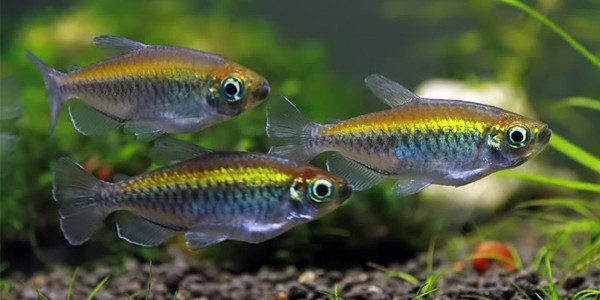For starters, it is important to say there are two kinds of fish when it comes to breeding: free-spawning (egg scatterers) and live bearing fish. The first type, free-spawning fish, just throw away their eggs and sperm in various random directions, and wait for magic to happen. Eventually, some of the eggs end up fertilized and with no parental care whatsoever.

On the other hand, females of livebearing fish, or simply livebearers, retain the eggs in their body and give birth to live, free-swimming young.
Livebearing fish in the aquarium
Livebearers seen in the aquarium are mostly members of Poeciliidae family, most common of which are guppies, mollies, platies, swordtails, black-bar Endler, and mosquito fish. Most of the Poeciliidae are ovoviviparous, which means the eggs are held in the female’s body for protection while being essentially independent from the mother, meaning they don’t receive any nutrients from her.
The rest of Poeciliidae, including splitfins and halfbeaks, is viviparous. The females provide the eggs with nutrients from the parent’s blood supply by means of a system analogous to a mammal’s placenta.
There are also specific kinds of livebearers, such as seahorses and pipefish, which are characterized by males incubating the young or mouthbrooders bearing the eggs in the oral cavity.
Breeding
The easiest way to tell the difference between the males and females is by looking at their anal fins. Unlike the female’s common fan shaped anal fin, males have elongated gonopodium that serves as a sperm transferring tube in the process of inseminating eggs inside the female.
You can also look at the shape and size of the body and coloration brightness: females are usually bigger than males, especially during breeding, and males have more vivid colors because in the wild, the males show off their bodies and colors knowing females are watching from some lurking place.
Commonly, males with the biggest bodies, fins, and brightest coloration get, in most cases, more than one female to breed with.
Ease of breeding is the main reason many claim these fish are excellent for beginners. The part requiring more attention and knowledge is actually raising the fry. They are bigger than newly hatched fry of the egg scatterers, have a lower chance of mortality, and are much easier to care for.
Still, hobbyist should be concerned about the other adult fish in the aquarium as well as the parents, whom become the predators to the juvenile fish, almost the very moment they are released.
Some of the fry will make it to the adult stage even with all the predation, but if you want to get as many young as possible to mature, there are three possible solutions to this problem.
The best way to start a fully controlled breeding process is to buy virgin females because it makes it easier to recognize males they are willing to breed with. Also, there is a large possibility males and females of the same coloration variety and/or coming from the same tank are related and breeding them could lead to genetic failures, such as deformities and disease.
If you still want to develop, for example, a specific coloration, it is best to buy males and females of the same color, but from unrelated batches. To maintain full control you should set up separate tanks for males and females and a third one for the breeding and growing fry later on.
To trigger the breeding, maintain the water by replacing 25% of it at least once a week and feed your livebearers plenty of flake and live foods to produce healthier and larger offspring. Once a female gets pregnant, it is easily recognized by a dark, gravid spot just above her genital pore and when it becomes as fat as on the point of exploding, the time has come for the babies to be released.
At that point, you should already have chosen the way to protect the young. You can do it either by isolating the female in a separate tank and removing her approximately 12 hours after offspring release since there is a surge of hormones released in the fish’s body that lasts 12 hours and prevents the fish from being hungry.
Also, removing the female too early is discouraged because it has proved stressful to the fish and may cause abortion of the pregnancy and possible later releases of fry.
Another way you can intervene is by setting a breeding trap, which goes inside the main tank and looks like a plastic, slotted box small enough to allow only young inside. Slots are also important for water circulation. Some traps on the market are even subdivided, offering the possibility of two or more females giving birth at the same time.
If you don’t have a spare breeding tank, consider setting up a breeding net. They are larger than traps and may serve as a good transition for the fry once they overgrow the traps. They can be made at home with mesh on a solid plastic construction.
Feeding the fry
The moment young are born they are ready to eat. Feed them two to three times a day with the smaller amounts of the version of food fed to the parents. Even if you keep species like black-bar Endler, which have one of the smallest fry, you can feed them on powdered flake food immediately after birth as well as natural fry food like daphnia and baby brine shrimp.
Needless to say, for the best results, you should keep the water clean by replacing 50% of the water every day or two.
No related posts.

1 thought on “Breeding Livebearing Fish”
hi im going to make a comunity tank with will have guppies,platies,swordtails and mollies can they still breed (with thier own type of course)with out being confuse?